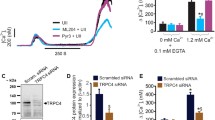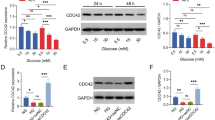Abstract
The role of metabolic acidosis in the progression of chronic kidney disease (CKD) remains unclear. The aim of the present study was to investigate the direct effects of acid loading on the proliferation of rat glomerular mesangial cells (GMCs) in vitro and the possible role of sodium–hydrogen ion exchanger isoform 1 (NHE1). Rat GMCs were treated with acidic medium as acid loading. Growth and proliferation of GMCs was studied by the 3-[4,5-dimethylthiazol-2-yl]-2,5-diphenyltetrazolium bromide (MTT) assay, thymidine (3H-TdR) incorporation, and flow cytometry. NHE1 protein expression and activity were quantified by Western blot and dual wavelength epifluorescent illumination with 2′,7′-bis-(2-carboxyethyl)-5(6)-carboxyfluorescein, respectively. 5-(N,N-dimethyl) amiloride hydrochloride (DMA), a specific inhibitor of NHE1, was used to investigate the possible involvement of NHE1 in the proliferation of GMCs. The MTT assay, 3H-TdR incorporation, and cell cycle distribution analysis indicated that acid loading stimulated the proliferation of GMCs. Acid loading increased NHE1 activity, but had no effects on NHE1 expression at the protein level. The effects of acid loading on the proliferation of GMCs were inhibited by DMA. Acid loading induced GMC proliferation through NHE1-dependent pathways. Our findings may contribute to the understanding of metabolic acidosis in the progression of CKD.




Similar content being viewed by others
References
Aharonovitz O, Zaun HC, Balla T, York JD, Orlowski J, Grinstein S (2000) Intracellular pH regulation by Na+/H + exchange requires phosphatidylinositol 4,5-bisphosphate. J Cell Biol 150:213–224
Bacchetta J, Harambat J, Cochat P, Salusky IB, Wesseling-Perrys K (2012) The consequences of chronic kidney disease on bone metabolism and growth in children. Nephrol Dial Transplant 27:3063–3071
Borsi GG, Svitkina TM (2000) Actin machinery: pushing the envelope. Curr Opin Cell Biol 12:104–112
Gadola L, Noboa O, Marquez MN, Rodriguez MJ, Nin N, Boggia J, Ferreiro A, Garcia S, Ortega V, Ml M, Ponte P, Sesser P, Pizarrosa C, Ravaglio S, Vallega A (2004) Calcium citrate ameliorates the progression of chronic renal injury. Kidney Int 65:1224–1230
Goraya N, Wesson DE (2012) Acid–base status and progression of chronic kidney disease. Curr Opin Nephrol Hypertens 21:552–556
Green J, Maor G (2000) Effect of metabolic acidosis on the growth hormone/IGF-I endocrine axis in skeletal growth centers. Kidney Int 57:2258–2267
Karmazyn M, Kilic A, Javadov S (2008) The role of NHE-1 in myocardial hypertrophy and remodeling. J Mol Cell Cardiol 44:647–653
Kemp G, Young H, Fliegel L (2008) Structure and function of the human Na+/H+ exchanger isoform 1. Channels 2:329–336
Klahr S, Morrissey J (2003) Progression of chronic renal disease. Am J Kidney Dis 41:S3–S7
Kovesdy CP (2012) Metabolic acidosis and kidney disease: does bicarbonate therapy slow the progression of CKD? Nephrol Dial Transplant 27:3056–3062
Li K, Gu Y, Lai L, Liu S, Hao C, Lin S (2005) Chronic metabolic acidosis markedly induces proliferation of mesangial cells in rats. Chi J Pathophysiol 21:1514–1519
Ling H, Ardjomand P, Samvakas S, Simm A, Busch GL, Lang F, Sebekova K, Heidland A (1998) Mesangial cell hypertrophy induced by NH4Cl: role of depressed activities of cathepsins due to elevated lysosomal pH. Kidney Int 53:1706–1712
Lόpez-Hάernndez FJ, Lόpez-Novoa JM (2012) Role of TGF-β in chronic kidney disease: an integration of tubular glomerular and vascular effects. Cell Tiss Res 347:141–154
Mraiche F, Oka T, Gan XT, Karmazyn M, Fliegel L (2011) Activated NHE1 is required to induce early cardiac hypertrophy in mice. Basic Res Cardiol 106:603–616
Matthew TJ, Brenda RH, Marcello T (2010) Early recognition and prevention of chronic kidney disease. Lancet 375:1296–1309
Mukhin YV, Garnovaskaya MN, Vllian ME (2004) Erk is regulated by sodium-proton exchanger in rat aortic vascular smooth muscle cells. J Biol Chem 279:1845–1852
Nath KA, Hostetter MK, Hostetter TH (1985) Pathophysiology of chronic tubulointerstitial disease in rats. Interactions of dietary acid load, ammonia, and complement component C3. J Clin Invest 76:667–675
Phisitkul S, Khannal A, Simoni J, Broglio K, Sheather S, Rajab MH (2010) Amelioration of metabolic acidosis in patients with low GFR reduced kidney endothelin production and kidney injury, and better preserved GFR. Kidney Int 77:617–623
Putney LK, Denker SP, Brarber DL (2002) The changing face of the Na+/H + exchanger, NHE1: structure, regulation, and cellular actions. Ann Rev Pharmacol Toxicol 42:527–552
Taal MW, Brenner BM (2008) Renal risk scores: progress and prospects. Kidney Int 73:1216–1219
Wakabayashi S, Pang T, Su X, Shigekawa M (2000) A novel topology model of the human Na(+)/H(+) exchanger isoform 1. J Biol Chem 275:7942–7949
Wesson DE, Simoni J (2010) Acid retention during kidney failure induces endothelin and aldosterone production which lead to progressive GFR decline, a situation ameliorated by alkali diet. KI 78:1128–1135
William DL (1965) Renal hypertrophy in metabolic acidosis and its relation to ammonia excretion. Am J Physiol 208:1135–1142
Winkel GK, Sardet C, Pouyssegur J, Ives HE (1993) Role of cytoplasmic domain of the Na+/H + exchanger in hormonal activation. J Biol Chem 268:3396–3400
Wu DM, Kraut JA (2011) Potential role of NHE1 in the cellular dysfunction of lactic acidosis, implications for treatment. AJKD 57:781–787
Wu DM, Russano K, Kauz I, Abraham WM (2013) NHE1 inhibition improves tissue perfusion and resuscitation outcome after severe hemorrhage. J Surg Res. doi:10.1016/j.jss.2012.07.026
Zhang M, Chen J, Liu S, You L, Lin SY, Gu Y (2009) The Role of Na + –H + exchanger isoform 1 in aldosterone-induced glomerulosclerosis in vivo. Renal Failure 31:726–735
Zhang M, Chen J, Lai LY, You L, Lin SY, Hao CM, Gu Y (2010) Aldosterone promotes fibronectin synthesis in rat mesangial cells via ERK1/2-stimulated Na+/H + exchanger isoform 1. Am J Nephrol 31:75–82
Acknowledgments
This work was supported by research grant #2012CB517700 from the Major State Basic Research Development Program of China (to YG), the third stage elaborate experimental project from Tongji University (to KL), and the National Natural Science Foundation of China (NSFC) Research Fund for International Young Scientists (81250110087 to JF).
Author information
Authors and Affiliations
Corresponding author
Additional information
Kun Li and Wei Su contributed equally to this study.
Electronic supplementary material
Below is the link to the electronic supplementary material.
ESM 1
(TIFF 553 kb)
Rights and permissions
About this article
Cite this article
Li, K., Su, W., Li, M. et al. Acid loading stimulates rat glomerular mesangial cells proliferation through Na+–H+ exchanger isoform 1 (NHE1)-dependent pathway. Naunyn-Schmiedeberg's Arch Pharmacol 386, 563–569 (2013). https://doi.org/10.1007/s00210-013-0856-1
Received:
Accepted:
Published:
Issue Date:
DOI: https://doi.org/10.1007/s00210-013-0856-1




